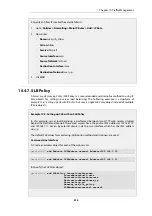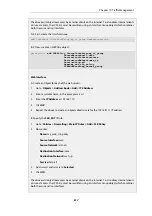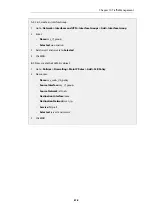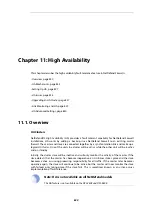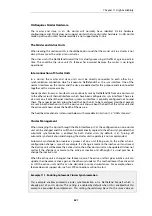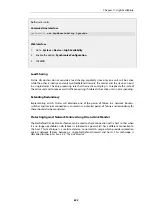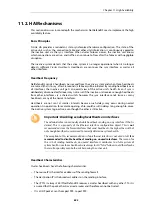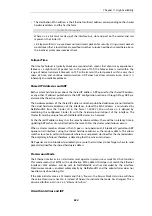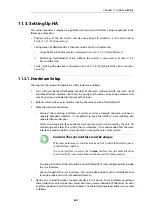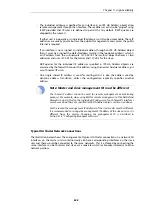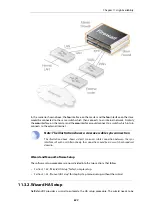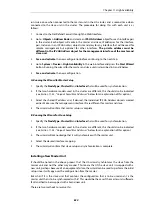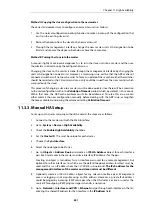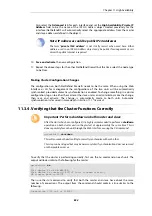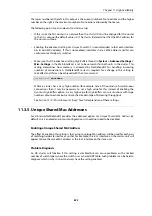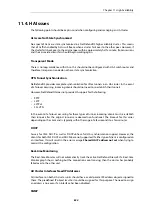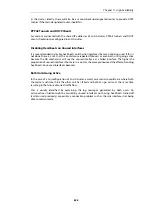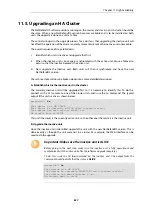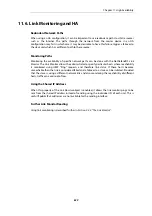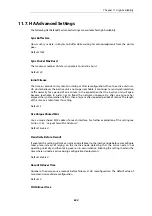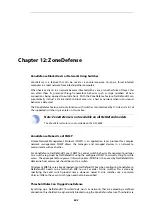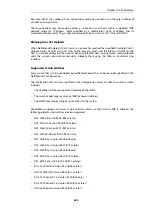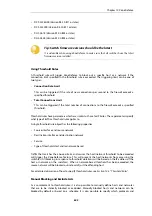
run twice: once when connected to the master unit in the HA cluster, and a second time when
connected to the slave unit in the cluster. The procedure for doing this with each unit is as
follows:
1.
Connect to the NetDefend Firewall through the Web Interface.
2.
Go to: Objects > Address Book and create an IP4 HA Address object for each interface pair
in the cluster. Each object will contain the master and slave IP addresses for the interface
pair. Inclusion in an
IP4 HA Address
object is mandatory for any interface that will be used for
remote management but optional for other interfaces. The private address must be
different in the IP4 HA Address object for the management interface of the master and
slave unit.
3.
Save and activate the new configuration before continuing to the next step.
4.
Go to System > Device > High Availability in the web interface and press the Start Wizard
button. Running the wizard for the master and slave units is described in
A
and
B
below.
5.
Save and activate the new configuration.
A. Running the Wizard for Master Setup
1.
Specify the NodeType, ClusterID and Interface that will be used for synchronization.
2.
If the two hardware models used in the cluster are different, this should also be indicated
(see
Section 11.3.5, “Unique Shared Mac Addresses”
below for an explanation of this option).
3.
Select the shared IP address and, if desired, the individual IP4 HA Address objects created
earlier. Make sure the management interface IPs are different for master and slave.
4.
The wizard will confirm that master setup is complete.
B. Running the Wizard for Slave Setup
1.
Specify the NodeType, ClusterID and Interface that will be used for synchronization.
2.
If the two hardware models used in the cluster are different, this should also be indicated
(see
Section 11.3.5, “Unique Shared Mac Addresses”
below for an explanation of this option).
3.
The wizard will acknowledge that it will synchronize with the master unit.
4.
Select the desired interface mapping.
5.
The wizard will confirm that slave setup and synchronization is complete.
Installing a New Master Unit
It should be noted in the above process that the HA wizard synchronizes the slave from the
master unit and not the other way around. This means that if the slave unit is swapped with a
new unit, perhaps because of an equipment failure, the wizard can be used to perform the initial
setup since it will copy over the configuration from the master.
But what if it is the slave unit that contains the configuration that is to be used and it is the
master unit that is to be synchronized with it? This would be the case if the master unit suffered a
fault and had to be swapped with a brand new unit.
There are two methods to resolve this:
Chapter 11: High Availability
830
Summary of Contents for NetDefendOS
Page 30: ...Figure 1 3 Packet Flow Schematic Part III Chapter 1 NetDefendOS Overview 30 ...
Page 32: ...Chapter 1 NetDefendOS Overview 32 ...
Page 144: ...Chapter 2 Management and Maintenance 144 ...
Page 284: ...Chapter 3 Fundamentals 284 ...
Page 392: ...Chapter 4 Routing 392 ...
Page 419: ... Host 2001 DB8 1 MAC 00 90 12 13 14 15 5 Click OK Chapter 5 DHCP Services 419 ...
Page 420: ...Chapter 5 DHCP Services 420 ...
Page 573: ...Chapter 6 Security Mechanisms 573 ...
Page 607: ...Chapter 7 Address Translation 607 ...
Page 666: ...Chapter 8 User Authentication 666 ...
Page 775: ...Chapter 9 VPN 775 ...
Page 819: ...Chapter 10 Traffic Management 819 ...
Page 842: ...Chapter 11 High Availability 842 ...
Page 866: ...Default Enabled Chapter 13 Advanced Settings 866 ...
Page 879: ...Chapter 13 Advanced Settings 879 ...

